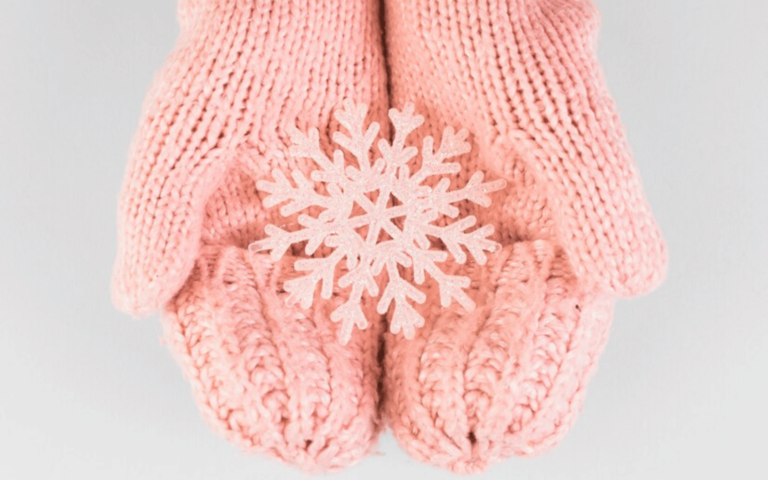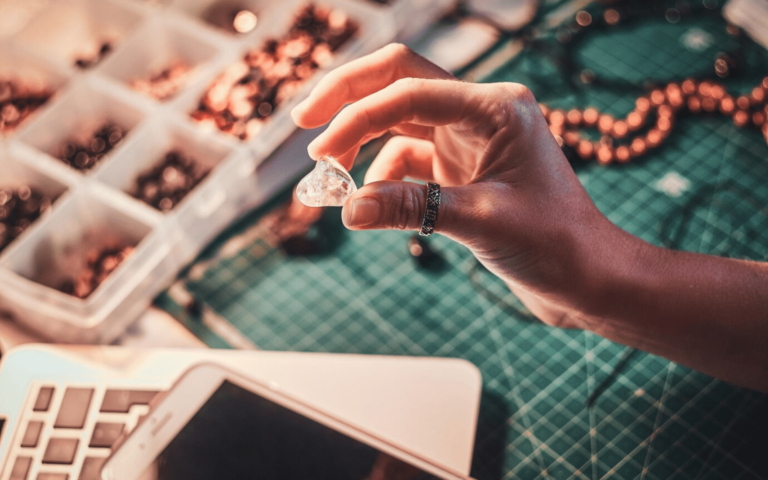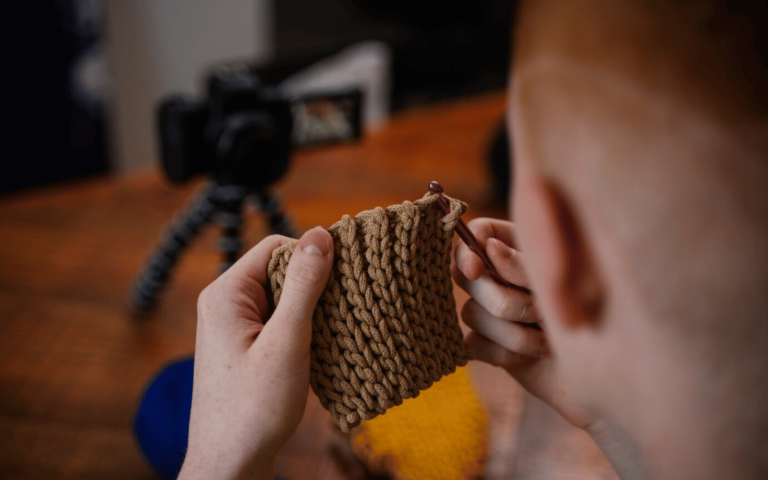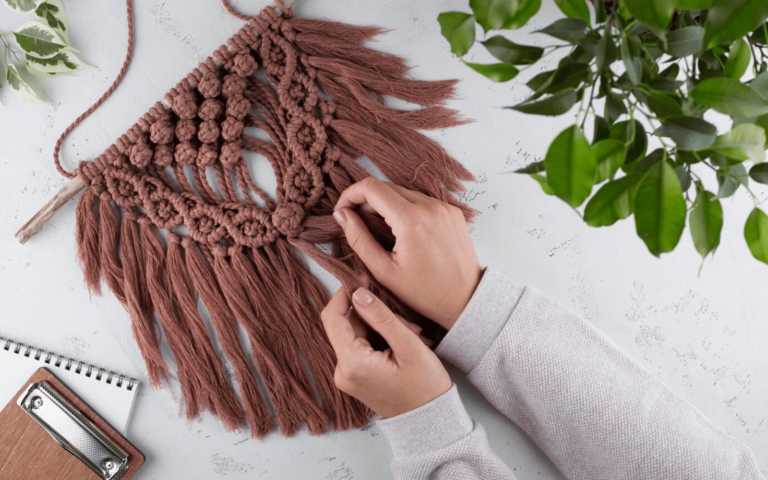Cable Stitch in Knitted Accessories
Knitting is an art form that has captured the hearts and needles of crafters for generations. Among the various knitting techniques, cable knitting stands out as a timeless and elegant style that adds depth, texture, and sophistication to your projects. In this comprehensive guide, we will delve deep into the world of cable knitting, with a particular focus on learning the cable stitch for creating stunning knitted accessories. Cable knitting has a rich history that dates back centuries. The intricate designs and twisted stitches of cable patterns were initially inspired by the rugged ropes and cables used in maritime settings. Over time, these patterns found their way into clothing, creating a unique and timeless aesthetic. Today, cable knitting remains a popular choice for knitters of all skill levels.
Understanding the cable stitch is a rewarding endeavor that opens up a world of creative possibilities. Whether you’re a beginner eager to learn the basics or an experienced knitter looking to expand your repertoire, this guide has something to offer. We will cover everything from the fundamentals of cable knitting to advanced techniques, troubleshooting common issues, and even showcasing your cable couture in style. So, grab your knitting needles and a skein of your favorite yarn, and let’s embark on a journey to learn the art of cable knitting for creating exquisite knitted accessories.
Understanding Cable Knitting
Cable knitting, at its core, is a technique that involves crossing stitches over each other to create twisting, braided-like patterns. These patterns can vary in complexity, from simple one-stitch cable crosses to intricate designs involving multiple stitches and rows. Understanding the fundamentals of cable knitting is before diving into more advanced projects. To begin your cable knitting journey, you’ll need some essential tools and materials. First and foremost, you’ll need a pair of knitting needles. The size of your needles should correspond to the yarn you’re using; thicker yarn requires larger needles, while finer yarn requires smaller ones. Additionally, choosing the right cable needle is essential. Cable needles are shorter and have a hook or bend in the middle to hold stitches as you work your cable crosses.
Cable knitting also involves a unique terminology and set of symbols. Familiarizing yourself with these symbols and instructions is essential for following cable patterns accurately. Many knitting patterns use standardized cable symbols, making it easier for knitters to understand and create intricate designs. These symbols typically represent actions like C2F (Cable 2 Front) or C2B (Cable 2 Back), which dictate the direction of the cable twist.
Finally, before you start knitting, you should pay close attention to your tension and gauge. Tension refers to how tightly or loosely you knit, while gauge is the number of stitches and rows per inch in your knitting. Achieving the correct tension and gauge is essential for ensuring that your cable knitting projects turn out the right size and shape. Switching and practicing your tension are steps before embarking on a larger cable project.
Getting Started with Cable Knitting
Now that you have your knitting tools and materials ready, it’s time to get started with cable knitting. This section will guide you through the initial steps of preparing your project and laying the foundation for your cable stitches. Choosing the right yarn and needles is a critical first step in any knitting project, and cable knitting is no exception. The choice of yarn can significantly impact the final look and feel of your cable accessory. For beginners, it’s advisable to select a smooth, medium-weight yarn in a light color. This will make it easier to see your stitches and cable crosses as you work.
Once you’ve selected your yarn, it’s time to choose the appropriate needles. As mentioned earlier, the size of your needles should match the yarn you’re using. Check the yarn label for recommendations on needle size, or consult the pattern you’ll be working with. Using the recommended needle size will help you achieve the correct tension and gauge for your project. With your yarn and needles in hand, you’re ready to cast on for cable knitting. The cast-on is the first row of stitches that you create on your knitting needle. There are various cast-on methods to choose from, but for cable knitting, a simple long-tail cast-on or a knitted cast-on is often suitable. Follow the instructions for your chosen cast-on method, ensuring that you leave a tail of yarn long enough to work your initial rows.
Creating a foundation row is the next step in getting started with cable knitting. This row of stitches will serve as the base for your cable pattern. Depending on the pattern you’re following, this may involve knitting several rows of a basic stitch pattern or setting up the stitches for your first cable cross. It’s essential to follow with attention the pattern instructions for the foundation row, as any mistakes here can affect the entire cable design. Once you’ve completed your foundation row, you’re ready to begin working the cable stitches themselves. Before diving into complex cable patterns, it’s a good idea to practice the basic cable stitch techniques. In the next section, we’ll delve into the fundamentals of cable stitches, including how to create twists and read cable charts.
Cable Stitch Fundamentals
The cable stitch is the heart of cable knitting, and understanding how to create those beautiful twists and crosses is essential. In this section, we’ll delve into the intricacies of the cable stitch, from the basic techniques to reading cable charts and avoiding common mistakes. At its core, a cable stitch involves crossing a set of stitches over another set to create a twist. The two most common cable crosses you’ll encounter are C2F (Cable 2 Front) and C2B (Cable 2 Back). These abbreviations indicate the direction in which you’ll cross the stitches. C2F means you’ll move the first two stitches to a cable needle and hold them in front of your work, while C2B involves holding the first two stitches behind your work.
The process of creating a cable twist is as follows: Knit the stitches leading up to the cable cross. Slip the designated number of stitches onto a cable needle (usually two for C2F or C2B). Hold the cable needle in the specified direction (front or back). Knit the next stitches from your left-hand needle. Finally, knit the stitches from the cable needle. The result is a beautifully twisted cable that stands out against the background of your knitting. Cable patterns will often provide detailed instructions for each cable cross, including the number of stitches involved and the direction of the twist. Understanding cable charts is another essential skill for cable knitting. Cable charts are visual representations of the cable patterns you’ll be knitting. They use symbols and lines to indicate where and how cable crosses occur within the knitting rows. Learning to read these charts allows you to visualize the cable design and follow it accurately as you work.
While cable knitting can be incredibly rewarding, it’s not without its challenges. Common mistakes in cable knitting include crossing stitches in the wrong direction, dropping stitches, or forgetting to hold the cable needle in front or back. These errors can result in a cable that doesn’t look quite right or even unravelling stitches. Fortunately, we’ll look into how to troubleshoot these issues in a later section. With the cable stitch fundamentals under your belt, you’re well on your way to knowing cable knitting. In the next section, we’ll dive into various cable stitch patterns, ranging from simple designs for beginners to more intricate patterns for experienced knitters.
Cable Stitch Patterns
Now that you’ve learned the basics of cable knitting and how to create cable twists, it’s time to analyze the world of cable stitch patterns. Cable patterns come in various levels of complexity, making them suitable for knitters of all skill levels. In this section, we’ll introduce you to a range of cable stitch patterns and provide examples to help you get started. Cable patterns are a fantastic way to add texture and visual interest to your knitting projects. Whether you’re knitting a scarf, hat, mittens, or even a sweater, cable stitches can elevate your creations from ordinary to extraordinary. Let’s begin by looking at some simple cable patterns that are perfect for beginners.
Simple Cable Patterns for Beginners
If you’re new to cable knitting, it’s a good idea to start with straightforward cable patterns to build your confidence and skills. Simple cable patterns often involve just a few stitches and rows, making them easy to memorize and execute. One classic example of a beginner-friendly cable pattern is the “Twisted Cable.” This pattern typically consists of two basic cable crosses—C2F and C2B—alternating with columns of knit and purl stitches. The result is a beautifully textured fabric that’s perfect for scarves, headbands, or even a cozy blanket.
Another simple cable pattern that’s great for beginners is the “Rope Cable.” This pattern mimics the appearance of twisted ropes and is created by crossing two sets of stitches over each other in a regular sequence. The result is a visually appealing cable design that looks more complex than it actually is. As you work on these simple cable patterns, you’ll become more comfortable with the cable knitting technique and gain confidence in your ability to create stunning cable accessories. Once you’re ready to take your skills to the next level, you can go into intermediate and advanced cable patterns.
Progressing to Intermediate and Advanced Cable Patterns
Intermediate and advanced cable patterns offer a wider range of design possibilities and challenges. These patterns often involve larger cable crosses, more intricate twists, and the incorporation of additional stitches such as lace or ribbing. One popular intermediate cable pattern is the “Horseshoe Cable.” This pattern features a central cable twist surrounded by columns of twisted stitches that resemble horseshoes. It’s a visually striking design that’s perfect for creating unique scarves or fingerless gloves. For those seeking a more advanced challenge, the “Aran Cable” pattern is a classic choice. Aran cables are known for their complexity and often involve intricate combinations of cables, twists, and textures. Sweaters and cardigans featuring Aran cable designs are highly sought after for their craftsmanship and timeless style.
Tips for Designing Your Cable Stitch Patterns
While following established cable patterns is a great way to create beautiful knitted accessories, you may eventually want to try your hand at designing your cable stitch patterns. Designing your cable patterns allows for endless creativity and personalization. In this section, we’ll dive into some tips and guidelines to help you get started with cable stitch pattern design. Designing your cable patterns can be an incredibly rewarding experience, allowing you to infuse your unique style and creativity into your knitting projects. By following the principles of cable design and experimenting with different combinations of twists, crosses, and textures, you can create truly one-of-a-kind cable accessories that showcase your artistic flair.
Knitting Cable Accessories
Now that you’ve learned about various cable stitch patterns and how to design your cable patterns let’s examine the exciting world of cable accessories. Cable knitting is particularly well-suited for creating accessories like scarves, hats, mittens, and more. In this section, we’ll guide you through the process of selecting the right pattern for your accessory project and provide a step-by-step guide to knitting a cable scarf.
Accessories are an excellent way to showcase your cable knitting skills while creating practical and stylish items for yourself or as thoughtful gifts for loved ones. Whether you’re a beginner looking for a straightforward project or an experienced knitter ready to tackle a more challenging design, there’s a cable accessory pattern to suit your needs. Cable accessories encompass a wide range of items that you can knit to add warmth and style to your wardrobe. Some popular cable accessories include scarves, hats, mittens, fingerless gloves, and boot cuffs. Each of these items provides an opportunity to experiment with different cable stitch patterns and create a unique piece that reflects your personal style.
Troubleshooting Cable Knitting Issues and Advanced Cable Techniques
As with any knitting technique, cable knitting can sometimes present challenges and issues that require troubleshooting. In this section, we’ll address common problems that knitters encounter while working with cables and provide solutions to help you overcome them. While cable knitting can be a rewarding and enjoyable technique, it’s not without its share of challenges. Understanding how to troubleshoot common cable knitting issues will ensure that your cable projects turn out beautifully and that you can tackle more complex patterns with confidence.
With a solid foundation in cable knitting, you’re now ready to look into more advanced cable techniques. In this section, we’ll dive into the world of complex cable patterns, reversible cables, and combining cable stitches with other knitting techniques to create truly extraordinary projects. Complex cable patterns take cable knitting to the next level by incorporating intricate twists, crossings, and unique stitch combinations. These patterns often require attention to detail and a willingness to tackle more advanced techniques. The result, however, is a stunning piece of knitwear that showcases your knitting prowess. One example of a complex cable pattern is the “Celtic Knot Cable.” This design features a series of interconnected cable crosses that create the appearance of traditional Celtic knots. The intricate nature of this pattern makes it a popular choice for knitting blankets, shawls, or even statement sweaters.
Finishing, Blocking and Showcasing Your Cable Couture
Finishing and blocking are steps in the cable knitting process that can make a significant difference in the final appearance and quality of your projects. In this section, we’ll examine the importance of blocking, how to block cable knit projects effectively, and the finishing touches that give your creations a polished look. Blocking is the process of shaping and setting your knitted fabric to its intended dimensions. It involves wetting your knitting, gently stretching or shaping it, and then allowing it to dry in the desired shape. Blocking not only improves the appearance of your cable knit projects but also helps to even out your stitches and create a more professional finish. Blocking is especially important in cable knitting because it allows you to open up the cable crosses, making them more defined and visually appealing. Without blocking, your cables may appear uneven or not fully showcase their intricate twists and turns.
After investing time and effort into learning cable knitting and creating stunning cable accessories, it’s time to showcase your cable couture. Now we’ll dig into various ways to display and share your cable knits, from photography tips to participating in knitting competitions and building a community of fellow cable knitting enthusiasts. Creating beautiful cable knit accessories is a labor of love, and sharing your creations with others can be a rewarding experience. Whether you’re looking to document your work, connect with fellow knitters, or even take your cable knitting to the next level by entering competitions, there are many ways to showcase your cable couture.
The Art of Knitting
a skill passed down through generations, has always held a special place in the hearts of craft enthusiasts around the world. With its rich history and endless possibilities for creativity, knitting offers a unique blend of tradition and innovation that continues to captivate the imagination. Among the many techniques that knitters have developed over the years, the cable stitch stands out as a distinctive and versatile method that adds texture and depth to knitted pieces. This technique involves crossing a group of stitches over each other to create twists and braids that elevate the visual appeal of the fabric, making it a popular choice for creating intricate designs in sweaters, scarves, and hats.
Delving deeper into the realm of cable knitting, one discovers the vast array of stitches that form the foundation of this technique. From the basic 2×2 and 4×4 cables to more complex patterns that involve multiple crossings and different stitch counts, the diversity of cable stitches is truly astonishing. Each pattern brings its own unique charm and character to knitted items, allowing knitters to experiment with various textures and designs. What’s more, the flexibility of cable knitting means that it can be easily adapted to suit different styles and preferences, making it a versatile tool in the knitter’s arsenal.
Moreover, the process of cable knitting itself is both meditative and rewarding. As knitters work their needles, carefully maneuvering stitches to create the desired twists and turns, they engage in a creative dance that is both calming and stimulating. The tactile experience of yarn slipping through fingers and the rhythmic clicking of needles provide a sensory delight that is as satisfying as the visual pleasure of seeing the cable patterns emerge. This blend of tactile and visual satisfaction is one of the reasons cable knitting remains a beloved technique among crafters.
In addition to the aesthetic and sensory pleasures of cable knitting, this technique also offers practical benefits. Cable-knitted items are not only beautiful to look at but also provide superior warmth and comfort. The raised patterns of the cables add extra thickness to the fabric, creating insulating layers that trap heat more effectively than flat-knit fabrics. This makes cable-knit accessories especially suited for colder climates, where they serve both a functional and decorative purpose. From cozy cable-knit scarves that wrap warmly around the neck to snug hats that keep the chill at bay, cable-knit accessories offer the perfect combination of style and practicality.
As knitters continue to explore and push the boundaries of cable knitting, the tradition evolves, incorporating new techniques and ideas. The advent of digital platforms and online communities has further enriched the cable knitting experience, enabling enthusiasts to share their creations, exchange tips, and inspire each other from across the globe. This sense of community and shared passion adds another layer of enjoyment to the craft, fostering connections and friendships among those who speak the common language of knitting.
Ultimately, the world of cable knitting is a testament to the enduring appeal of handcrafted items in a fast-paced, digital age. In a time when mass-produced goods are the norm, cable-knit accessories stand out as symbols of individuality and craftsmanship. They represent the love and care that goes into creating something by hand, imbued with personal touches that cannot be replicated by machines. Whether passed down as heirlooms or given as gifts, cable-knit items carry with them stories and memories, connecting people through the threads of time.
The journey into cable knitting is one of discovery, creativity, and connection. From its historical roots to its contemporary applications, cable knitting offers a rich tapestry of experiences for those willing to delve into its intricacies. Whether one is a novice looking to learn the basics or an experienced knitter seeking new challenges, the world of cable stitch knitting is replete with opportunities for exploration and growth. As knitters around the world continue to weave their stories into the fabric of their creations, the tradition of cable knitting remains a vibrant and evolving art form, cherished for its beauty, versatility, and the sense of community it fosters.
Exploring the Creative Realm of Cable Stitch
The historical tapestry of cable knitting is as intricate and twisted as the patterns it produces. Originating from the rugged islands of the Aran, off the coast of Ireland, cable stitch patterns were more than just decorative elements for the fishermen’s sweaters; they were imbued with symbols of family heritage and hopes for safety and prosperity. This rich lineage, however, is just the beginning of cable knitting’s journey across cultures and epochs. As the technique voyaged beyond its Gaelic cradle, it underwent a fascinating evolution, absorbing influences and adapting to the changing tastes and needs of knitters worldwide. This cultural odyssey has made cable knitting a versatile and enduringly popular technique among crafters, both for its aesthetic appeal and the depth of history knitted into each loop.
Yet, the true beauty of cable knitting transcends its visual allure and historical roots. It lies in the communal tapestry it weaves among knitters. In every yarn shop, crafting circle, and online forum, enthusiasts of all skill levels exchange knowledge, patterns, and stories, fostering a sense of community and continuity. This collective endeavor not only preserves the craft but also propels it into the future, encouraging innovation and the reimagining of traditional patterns to suit contemporary styles and technologies. Cable knitting, thus, becomes a living tradition, constantly evolving yet deeply rooted in its past.
Moreover, the global journey of cable knitting highlights its adaptability and resilience. From the woolen sweaters of Irish fishermen to the chic runways of high fashion, cable patterns have adorned a myriad of items, proving their versatility across different materials, scales, and contexts. This adaptability has allowed cable knitting to flourish in diverse environments, appealing to crafters with varying tastes, needs, and cultural backgrounds. It is a testament to the technique’s universal appeal and the shared human desire to create beauty and meaning through handcraft.
The exploration of cable knitting’s historical and cultural dimensions thus enriches our understanding of the craft. It invites knitters to view their work as part of a larger narrative, connecting them to generations of crafters who have passed down their knowledge and passion through every twist and turn of the yarn. This perspective fosters a deeper appreciation for the craft, not merely as a hobby or a means to produce beautiful objects but as a cultural heritage that knitters are privileged to contribute to and carry forward.
In this light, cable knitting is more than just a technique; it is a journey through time and across cultures, a dialogue between past and present, and a celebration of the human spirit’s creativity and resilience. As we continue to explore and expand the boundaries of cable knitting, we not only pay homage to its rich history but also contribute to its vibrant future. This ongoing odyssey, marked by each knitter’s unique contributions, ensures that cable knitting remains a beloved and dynamic element of the crafting world.
Outcome
In the end, knowing the cable stitch in knitted accessories opens up a world of creativity and craftsmanship. Whether you’re a beginner eager to learn or an experienced knitter seeking new challenges, cable knitting offers endless possibilities for creating beautiful and unique pieces. We’ve analyzed the fundamentals of cable knitting, from understanding cable stitches and patterns to troubleshooting common issues and learning advanced techniques. With this knowledge, you can confidently tackle cable accessory projects, design your cable patterns, and showcase your cable couture for the world to see. So, pick up your knitting needles and let your creativity flow as you embark on your cable knitting journey. With dedication and practice, you’ll soon be crafting exquisite cable accessories that are both functional and works of art. Happy knitting!
See More At: woolen8wonders.com







